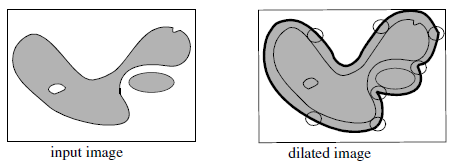Package com.openinventor.imageviz.engines.mathematicalmorphology.erosionanddilation
In an erosion, pixel values within the structuring element are set to the minimum value of the element. In a binary image, an erosion removes isolated points and small particles, shrinks other particles, discards peaks at the object boundaries, and disconnects some particles.
Erosion modules are reiterative: repeating an erosion or dilation of size 1 N times has the same effect as performing a single erosion with a structuring element of size N.
In Figure 4 the binary image is I, and X denotes the set of points with a value of 1. The erosion of I by the structuring element B results in the set of points x, where the disk representing B and cenetred on x is totally included in the set of points X. The erosion of I can be denoted as  or
or  .
.
 The eroded set of X by the structuring element B is:
The eroded set of X by the structuring element B is: 
It may also be written as: 
The value of the structuring element (B) varies depending on the type of erosion. On a gray level image, the erosion by the structuring element B is the search for the minimal value of intensities within B.
- 2D image :
 .
.
- 3D image :
 .
.
When the point hits the edge of the image, the structuring element is composed of the intersection of B with the points of the structuring element totally within the image, and not the points outside the image.
In a dilation, pixel values within the disc are set to the maximum value of the pixel neighborhood. In a binary image, a dilation fills the small holes inside particles and gulfs at the object boundaries, enlarges the size of the particles and may connect neighboring particles.
Dilation modules are reiterative: repeating an erosion or dilation of size 1 N times has the same effect as performing a single erosion with a structuring element of size N.
In Figure 5, the binary image is I, and X denotes the set of points with a value of 1. The dilation of I by the structuring element B results in the set of points x, where the disc representing B and centered on x has a non empty intersection with the set of points X. The dilation of I can be denoted as  or
or  .
.
 The dilated set of X by the structuring element B is:
The dilated set of X by the structuring element B is: 
It may also be expressed as: 
The value of the structuring element (B) varies depending on the type of erosion. On a gray level image, the dilation by the structuring element B is the search for the maximum value of intensities within B:
- 2D image :
 .
.
- 3D image :
 .
.
When the point hits the edge of the image, the structuring element is composed of the intersection of B with the points of the structuring element totally within the image, and not the points outside the image.
-
Class Summary Class Description SoDilationBallProcessing3d Deprecated. As of Open Inventor 2023.2.SoDilationCubeProcessing Deprecated. As of Open Inventor 2023.2.SoDilationDiskProcessing2d Deprecated. As of Open Inventor 2023.2.SoDilationDiskProcessing3d Deprecated. As of Open Inventor 2023.2.SoDilationLineProcessing2d Deprecated. As of Open Inventor 2023.2.SoDilationLineProcessing3d Deprecated. As of Open Inventor 2023.2.SoDilationSquareColorProcessing2d Deprecated. As of Open Inventor 2023.2.SoErosionBallProcessing3d Deprecated. As of Open Inventor 2023.2.SoErosionCubeProcessing Deprecated. As of Open Inventor 2023.2.SoErosionDiskProcessing2d Deprecated. As of Open Inventor 2023.2.SoErosionDiskProcessing3d Deprecated. As of Open Inventor 2023.2.SoErosionLineProcessing2d Deprecated. As of Open Inventor 2023.2.SoErosionLineProcessing3d Deprecated. As of Open Inventor 2023.2.SoErosionSquareColorProcessing2d Deprecated. As of Open Inventor 2023.2.